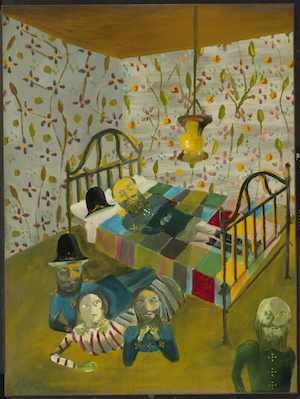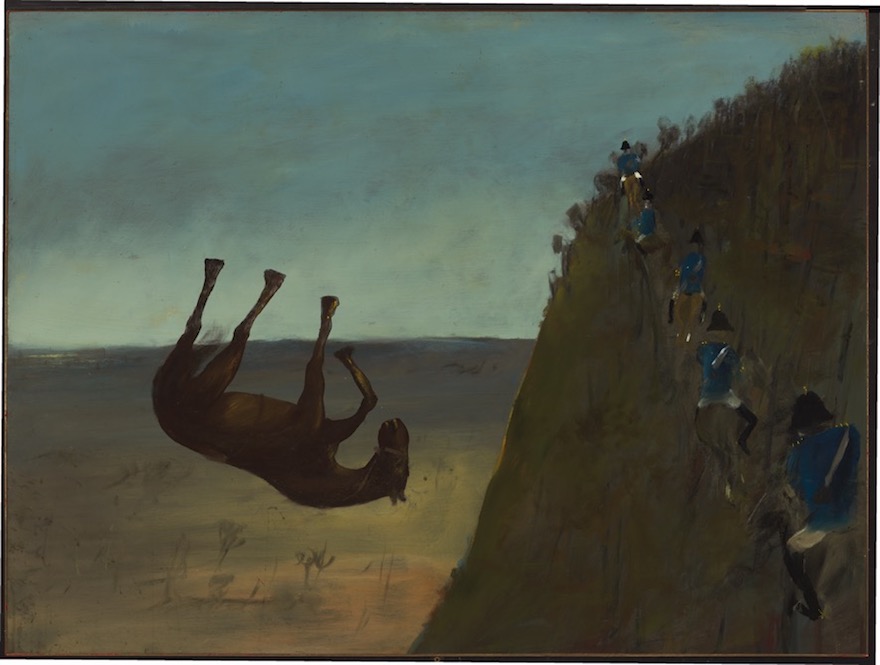Review: ‘Sidney Nolan’s Ned Kelly series’ ·
Art Gallery of Western Australia ·
Review by Miranda Johnson ·
“Sidney Nolan’s Ned Kelly series”, currently at the Art Gallery of Western Australia (AGWA), is firmly embedded in our collective cultural consciousness, an exploration of the folk hero’s life as well as a unique insight into the landscapes of the Australian bush. This exhibition brings together the 26 paintings of the National Gallery of Australia’s Ned Kelly collection, displayed as part of AGWA’s “Rebels, Radicals and Pathfinders” series.
The paintings, displayed here in standard chronological order, take us through the familiar dramatic circumstances of Kelly’s life. As has been frequently pointed out, however, the images are not intended to realistically represent the facts of Kelly’s life; rather, they are a blend of semi-autobiographical and imagined fictions, placed together to create an extended consideration of culture, landscape and the influence of a single person on a larger version of history.

National Gallery of Australia.
Nolan’s deliberately naïve depictions of Kelly take us through the story with a skilful hand. We move from the seemingly idyllic landscape painting that marks the beginning of the drama, through to the murder of a policeman at Stringybark Creek, the police chase, the marriage of spy Aaron Nevitt, the siege of Glenrowan Hotel and Kelly’s trial, which ended in a death sentence. The combination of Nolan’s inventive details and the quotations on the didactic panels (taken from historical news sources as well as the Royal Commission Report of 1881 conducted into the police force’s hunt for the Kelly gang) further help to combine history and fiction. Some of the paintings are so familiar they’re embedded in my brain, but I found that it was the minor details that fascinated me – Kate Kelly being pulled onto the constable’s lap, her face a deliberately controlled canvas of tension and watchfulness that I’m pretty sure most women would recognise, or the image of a police horse tumbling off a cliff, its upside-down state of suspension both darkly absurd and incredibly haunting.

The paintings are hung quite low, presumably to help to engage children, as is also suggested by an extra series of didactic panels, with questions for children. As a fairly short person, I actually found the low hang to be refreshing, as it enabled me to stand quite close to the paintings without having to crane my neck! As I moved around the room, I found that the gap in the wall that leads to the next room was slightly distracting, so embedded in Nolan’s Kelly narrative was I that it felt jarring to almost accidentally find myself in another room, right in the middle of the drama. I suspect, however, that this was a deliberate choice, as the glimpse into the next room shows Australian landscape portraits from AGWA’s historical collection.
This glimpse, then, links Nolan’s paintings with a wider tradition of painting that attempts to capture the vagaries of the Australian bush landscape. But Nolan’s paintings are so reliant on a particular myth and narrative, as well as an immediately recognisable style, that I felt like they deserved their own, slightly larger space. It takes time to absorb the series, and a larger, single room would have given visitors space to do so.
This opportunity to see the Kelly series is deeply engaging, nonetheless, as Nolan’s paintings combine vivid details of high drama, tension and dark humour with a fascination of the landscape of the Australian bush.
“Sidney Nolan’s Ned Kelly Series” shows at the Art Gallery of WA until November 12.
Pictured top: Sidney Nolan, ”Stringybark Creek”, 1947, from the Ned Kelly series 1946 – 1947, enamel paint on composition board, 90.70 x 121.50 cm, Gift of Sunday Reed, 1977 , National Gallery of Australia.
Like what you're reading? Support Seesaw.






